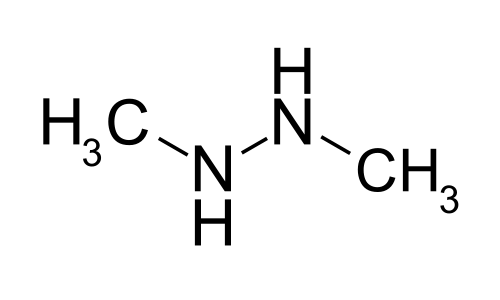1,2-Dimethylhydrazine
1,2-Dimethylhydrazine, or symmetrical dimethylhydrazine, is the organic compound with the formula (CH3NH)2. It is one of the two isomers of dimethylhydrazine. Both isomers are colorless liquids at room temperature, with properties similar to those of methylamines. 1,2-Dimethylhydrazine is a potent carcinogen that acts as a DNA methylating agent. The compound has no commercial value, in contrast to its isomer, which is used as a rocket fuel.[4]
 | |
 | |
| Names | |
|---|---|
| IUPAC name
1,2-Dimethylhydrazine[1] | |
| Other names | |
| Identifiers | |
CAS Number |
|
3D model (JSmol) |
|
| Abbreviations | SDMH[2] |
| ChEBI | |
| ChEMBL | |
| ChemSpider | |
| ECHA InfoCard | 100.149.162 |
| KEGG | |
| MeSH | 1,2-Dimethylhydrazine |
PubChem CID |
|
| UNII | |
CompTox Dashboard (EPA) |
|
InChI
| |
SMILES
| |
| Properties[3] | |
Chemical formula |
C2H8N2 |
| Molar mass | 60.100 g·mol−1 |
| Appearance | Colourless liquid |
| Odor | Ichtyal, ammoniacal |
| Density | 827.4 kg m−3 (at 20 °C) |
| Melting point | −9 °C (16 °F; 264 K) |
| Boiling point | 87 °C; 188 °F; 360 K |
Solubility in water |
Miscible |
| Thermochemistry | |
Heat capacity (C) |
171.04 J K−1 mol−1 |
Std molar entropy (S |
199.15 J K−1 mol−1 |
Std enthalpy of combustion (ΔcH⦵298) |
−1987–−1978 kJ mol−1 |
| Related compounds | |
Related compounds |
|
Except where otherwise noted, data are given for materials in their standard state (at 25 °C [77 °F], 100 kPa). | |
| Infobox references | |
It is used to induce colon tumors in experimental animals - particularly mice and feline cell samples.[1][5][6]
See also
References
- 1,2-Dimethylhydrazine from PubChem
- 74-79-3 1,2-Dimethylhydrazine
- Record of 1,2-Dimethylhydrazin in the GESTIS Substance Database of the Institute for Occupational Safety and Health, accessed on 21 March 2008.
- Gangadhar Choudhary, Hugh Hansen (1998). "Human health perspective of environmental exposure to hydrazines: A review". Chemosphere. 37: 801–843. doi:10.1016/S0045-6535(98)00088-5.
- Cruse, J. P.; Lewin, M. R.; Ferulano, G. P.; Clark, C. G. (1978). "Co-carcinogenic effects of dietary cholesterol in experimental colon cancer". Nature. 276 (5690): 822–5. doi:10.1038/276822a0. PMID 723955.
- Wijnands, M.V.W. (1999). "A comparison of the effects of dietary cellulose and fermentable galacto-oligosaccharide, in a rat model of colorectal carcinogenesis: fermentable fibre confers greater protection than non-fermentable fibre in both high and low fat backgrounds". Carcinogenesis. 20 (4): 651–6. doi:10.1093/carcin/20.4.651. PMID 10223195.
This article is issued from Wikipedia. The text is licensed under Creative Commons - Attribution - Sharealike. Additional terms may apply for the media files.